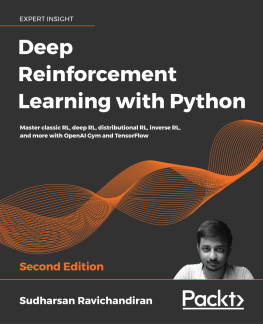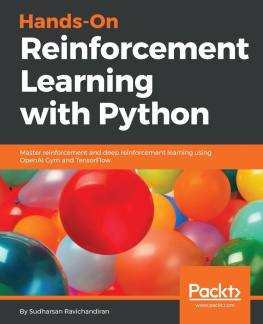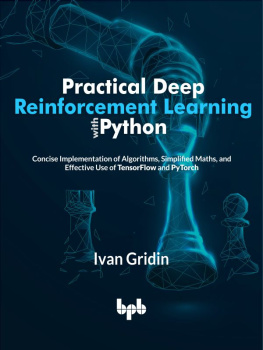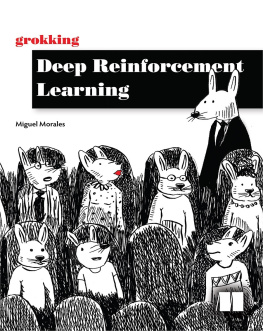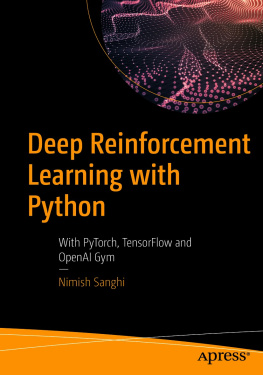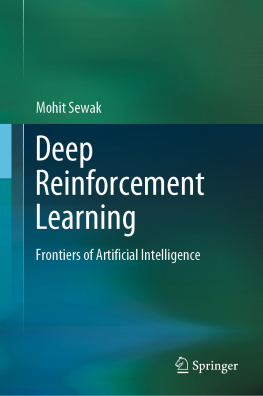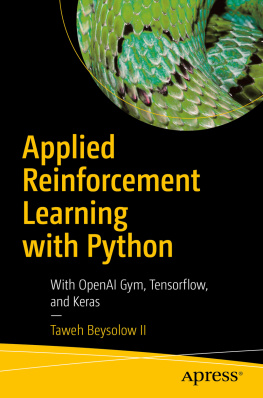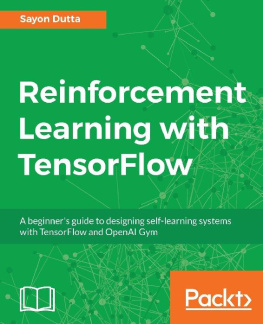Deep Reinforcement Learning with Python
Second Edition
Master classic RL, deep RL, distributional RL, inverse RL, and more with OpenAI Gym and TensorFlow
Sudharsan Ravichandiran

BIRMINGHAM - MUMBAI
Deep Reinforcement Learning with Python
Second Edition
Copyright 2020 Packt Publishing
All rights reserved. No part of this book may be reproduced, stored in a retrieval system, or transmitted in any form or by any means, without the prior written permission of the publisher, except in the case of brief quotations embedded in critical articles or reviews.
Every effort has been made in the preparation of this book to ensure the accuracy of the information presented. However, the information contained in this book is sold without warranty, either express or implied. Neither the author, nor Packt Publishing or its dealers and distributors, will be held liable for any damages caused or alleged to have been caused directly or indirectly by this book.
Packt Publishing has endeavored to provide trademark information about all of the companies and products mentioned in this book by the appropriate use of capitals. However, Packt Publishing cannot guarantee the accuracy of this information.
Producers: Ben Renow-Clarke and Aarthi Kumaraswamy
Acquisition Editor Peer Reviews: Divya Mudaliar
Content Development Editor: Bhavesh Amin
Technical Editor: Aniket Shetty
Project Editor: Janice Gonsalves
Copy Editor: Safis Editing
Proofreader: Safis Editing
Indexer: Pratik Shirodkar
Presentation Designer: Pranit Padwal
First published: June 2018
Second edition: September 2020
Production reference: 1291119
Published by Packt Publishing Ltd.
Livery Place
35 Livery Street
Birmingham B3 2PB, UK.
ISBN 978-1-83921-068-6
www.packt.com
To my adorable mom, Kasthuri, and to my beloved dad, Ravichandiran.
- Sudharsan Ravichandiran

packt.com
Subscribe to our online digital library for full access to over 7,000 books and videos, as well as industry leading tools to help you plan your personal development and advance your career. For more information, please visit our website.
Why subscribe?
- Spend less time learning and more time coding with practical eBooks and Videos from over 4,000 industry professionals
- Learn better with Skill Plans built especially for you
- Get a free eBook or video every month
- Fully searchable for easy access to vital information
- Copy and paste, print, and bookmark content
Did you know that Packt offers eBook versions of every book published, with PDF and ePub files available? You can upgrade to the eBook version at www.Packt.com and as a print book customer, you are entitled to a discount on the eBook copy. Get in touch with us at customercare@packtpub.com for more details.
At www.Packt.com , you can also read a collection of free technical articles, sign up for a range of free newsletters, and receive exclusive discounts and offers on Packt books and eBooks.
Contributors
About the author
Sudharsan Ravichandiran is a data scientist, researcher, best-selling author, and YouTuber (search for Sudharsan reinforcement learning). He completed his bachelor's in information technology at Anna University. His area of research focuses on practical implementations of deep learning and reinforcement learning, which includes natural language processing and computer vision. He is an open source contributor and loves answering questions on Stack Overflow. He also authored a best-seller, Hands-On Reinforcement Learning with Python, 1st edition, published by Packt Publishing.
I would like to thank my most amazing parents and my brother, Karthikeyan, for inspiring and motivating me. My huge thanks to the producer of the book, Aarthi, and the editors, Bhavesh, Aniket, and Janice. Special thanks to the reviewers, Sujit Pal and Valerii Babushkin, for providing their valuable insights and feedback. Without all their support, it would have been impossible to complete this book.
About the reviewers
Sujit Pal is a Technology Research Director at Elsevier Labs, an advanced technology group within the Reed-Elsevier Group of companies. His areas of interests include semantic search, natural language processing, machine learning, and deep learning. At Elsevier, he has worked on several initiatives involving search quality measurement and improvement, image classification and duplicate detection, and annotation and ontology development for medical and scientific corpora. He has co-authored a book on deep learning and writes about technology on his blog Salmon Run.
Valerii Babushkin is the senior director of data science at X5 Retail Group, where he leads a team of 100+ people in the area of natural language processing, machine learning, computer vision, data analysis, and A/B testing. Valerii is a Kaggle competitions Grand Master, ranking globally in the top 30. He studied cybernetics at Moscow Polytechnical University and mechatronics at Karlsruhe University of Applied Sciences and has worked with Packt as an author of the Python Machine Learning Tips, Tricks, and Techniques course and a technical reviewer for some books on reinforcement learning.
Preface
With significant enhancement in the quality and quantity of algorithms in recent years, this second edition of Hands-On Reinforcement Learning with Python has been revamped into an example-rich guide to learning state-of-the-art reinforcement learning (RL) and deep RL algorithms with TensorFlow 2 and the OpenAI Gym toolkit.
In addition to exploring RL basics and foundational concepts such as the Bellman equation, Markov decision processes, and dynamic programming, this second edition dives deep into the full spectrum of value-based, policy-based, and actor-critic RL methods. It explores state-of-the-art algorithms such as DQN, TRPO, PPO and ACKTR, DDPG, TD3, and SAC in depth, demystifying the underlying math and demonstrating implementations through simple code examples.
The book has several new chapters dedicated to new RL techniques including distributional RL, imitation learning, inverse RL, and meta RL. You will learn to leverage Stable Baselines, an improvement of OpenAI's baseline library, to implement popular RL algorithms effortlessly. The book concludes with an overview of promising approaches such as meta-learning and imagination augmented agents in research.
Who this book is for
If you're a machine learning developer with little or no experience with neural networks interested in artificial intelligence and want to learn about reinforcement learning from scratch, this book is for you. Basic familiarity with linear algebra, calculus, and Python is required. Some experience with TensorFlow would be a plus.
What this book covers
Chapter 1, Fundamentals of Reinforcement Learning

